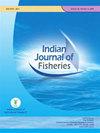Contribution of floodplain wetland (beel) fisheries to livelihood and nutritional security of fishers in Eastern India
IF 0.3
4区 农林科学
Q4 FISHERIES
引用次数: 0
Abstract
The floodplain wetlands or the oxbow lakes support millions of rural poor for earning their livelihood and nutritionalsecurity. The present study was conducted among the fisher households in two floodplain wetlands (locally known asbeel) of West Bengal (Kholsi and Akaipur) and one in Assam (Deepor). One hundred fisher households from West Bengaland 80 fisher households from Assam were selected using simple random sampling method. The study indicated that thesocio-economic conditions of the fisher households based on the level of education, operational holdings and off farmincome were well below the desired level. Fishing was the major occupation of around 70% of the fishers of West Bengaland 90% of fishers of Assam. The fishery contributed more than 60% of the household income to 42% fishers of West Bengaland 90% of fishers of Assam. In Deepor Beel it was found that no fisher household received less than 40% of their livelihoodfrom the beel. Further, the study showed that beel fishes were the only source of animal protein to more than 71% of thehouseholds of Deepor Beel. Similarly, more than 68% of households in West Bengal beels obtained animal proteins throughfishes caught in the beel itself. For sustainable use of wetland resources and to ensure livelihood and food security, there isa need to design appropriate management strategies. Arrangement of supplementary livelihood options was prescribed forthe fishers to reduce the fishing pressure on the wetlands. Keywords: Animal protein, Assam, Fishers, Floodplain wetlands, Livelihood, West Bengal东印度漫滩湿地渔业对渔民生计和营养安全的贡献
洪泛平原湿地或牛轭湖为数百万农村穷人提供生计和营养保障。本研究在西孟加拉邦(Kholsi和Akaipur)的两个洪泛平原湿地(当地称为beel)和阿萨姆邦(Deepor)的一个洪泛湿地的渔民家庭中进行。采用简单随机抽样方法从西孟加拉邦的100户渔民和阿萨姆邦的80户渔民中选出。研究表明,基于教育水平、经营资产和农场外收入的渔民家庭的社会经济状况远低于预期水平。捕鱼是西孟加拉邦约70%的渔民和阿萨姆邦90%的渔民的主要职业。渔业为西孟加拉邦42%的渔民和阿萨姆邦90%的渔民贡献了60%以上的家庭收入。在Deepor Beel发现,没有一个渔民的生活收入低于40%。此外,研究表明,beel鱼是Deepor beel 71%以上家庭动物蛋白质的唯一来源。同样,西孟加拉邦超过68%的家庭通过养蜂本身捕获的鱼类获得动物蛋白质。为了可持续利用湿地资源,确保生计和粮食安全,需要制定适当的管理战略。规定了渔民的补充生计选择安排,以减轻湿地的捕鱼压力。关键词:动物蛋白,阿萨姆邦,渔民,洪泛平原湿地,生计,西孟加拉邦
本文章由计算机程序翻译,如有差异,请以英文原文为准。
求助全文
约1分钟内获得全文
求助全文
来源期刊

Indian Journal of Fisheries
FISHERIES-
CiteScore
0.90
自引率
20.00%
发文量
0
审稿时长
6-12 weeks
期刊介绍:
Indian Journal of Fisheries is published quarterly by the Indian Council of Agricultural Research (ICAR), New Delhi. Original contributions in the field of Fish and fisheries science are considered for publication in the Journal. The material submitted must be unpublished and not under consideration for publication elsewhere.
Papers based on research which kills or damages any species, regarded as thratened/ endangered by IUCN crieteria or is as such listed in the Red Data Book appropriate to the geographic area concerned, will not be accepted by the Journal, unless the work has clear conservation objectives.
 求助内容:
求助内容: 应助结果提醒方式:
应助结果提醒方式:


